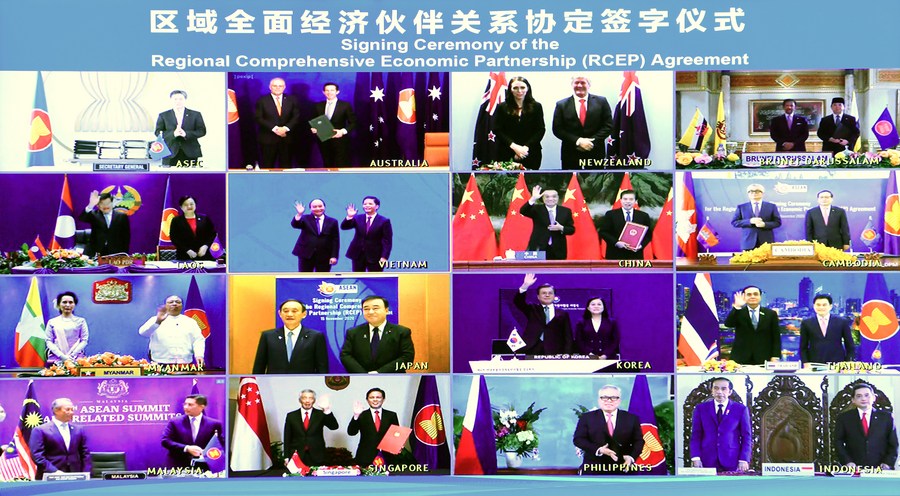China eyes all-around opening-up through RCEP: experts

Chinese Premier Li Keqiang and leaders of other countries attend the signing ceremony of the Regional Comprehensive Economic Partnership (RCEP) agreement after the fourth RCEP Summit, which is held via video link, Nov. 15, 2020. (Xinhua/Zhang Ling)
The ASEAN Secretariat issued an announcement on Nov. 2 that the Regional Comprehensive Economic Partnership (RCEP) agreement had reached the necessary threshold to come into force. When the agreement takes effect on Jan. 1, 2022, those countries that have submitted instruments of ratification/acceptance (IOR/A) to the ASEAN Secretariat will be able to access the benefits of the agreement, which includes six ASEAN member states – Brunei, Cambodia, Laos, Singapore, Thailand, and Vietnam – and four non-ASEAN signatory states – China, Japan, New Zealand, and Australia.
Joining the RCEP was yet another step taken by China to further expand its process of opening-up since its entry into the WTO, and it demonstrates China’s resolve to continuously expand opening-up while pushing forward mutual benefits and win-win results, experts and scholars told People’s Daily Online recently. When the RCEP takes effect, it is expected to inject renewed certainty for the continued economic growth of countries within the region as well as for countries of the wider world.
In November 2020, the RCEP member states formally signed the agreement, which covers a significant share of the world’s population, economy and trade, and has shown great potential for future development. The establishment of the RCEP will create an integrated largescale market comprising around one third of the global economy. The RCEP plays a positive role in helping China to accelerate its new development pattern revolving around dual circulation while propelling the global economic recovery.
“RCEP is the world’s largest free trade zone, covering a population more than four times that covered by the Comprehensive and Progressive Agreement for Trans-Pacific Partnership (CPTPP), and an economic size that is twice that under the CPTPP,” said Cui Fan, a professor at the University of International Business and Economics based in Beijing. The RCEP will play a significant role in improving regional value chains and boosting global economic recovery in the post-pandemic era, he pointed out.
The RCEP agreement is different from other big trade agreements in that its member states have a comparatively large economic development gap and strong industrial complementarities, said Ma Yingying, an assistant researcher at the Chinese Academy of Social Sciences’ global economy and politics research institute. Once the RCEP agreement takes effect, tariffs on 91 percent of commodities will be phased out. This, together with the establishment of common rules for the service trade and international investment, will largely facilitate a boost in trade throughout the zone.
One benefit the RCEP agreement will bring about after it takes effect is that it will give consumers a wider range of cost-effective imported commodities to choose from. According to an agreement signed between China and Japan under the RCEP framework, the proportion of Japanese products that China will import with exemptions from tariffs is set to skyrocket from 8 percent to 86 percent.
Given that the RCEP agreement puts forward requirements and makes commitments for lowering or exempting tariffs, it is expected to reduce the prices of imported commodities and introduce new products from various countries into domestic markets, said Ma.
After the RCEP agreement takes effect, it will see more high-quality goods and services from around the world flow into the Chinese consumer market, said Cui Weijie, deputy director of the Chinese Academy of International Trade and Economic Cooperation under the Ministry of Commerce. He added that the RCEP agreement will also help to drive the consumption upgrading of the domestic market, effectively improving the ability of the supply system to meet the demand of the domestic market, and unleashing China’s huge consumption potential.
Photos
Related Stories
- RCEP to boost regional GDP by 0.86% by 2035: report
- RCEP expected to effectively boost economic recovery
- RCEP will soon take effect in boost for regional cooperation
- World's largest trade deal RCEP to enter into force on Jan. 1, 2022
- China, Brunei call for RCEP's early entry into force
- Brunei ratifies RCEP, world's biggest free trade pact including China, ASEAN
Copyright © 2021 People's Daily Online. All Rights Reserved.










